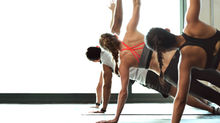Want to Squat Like A Pro? Here are 7 Common Mistakes to Avoid
- Juliet Ellorin
- Sep 4, 2022
- 3 min read
Squats is known as the most effective lower body exercises and are highly efficient, when executed properly . Though it's a very simple movement it can hit major muscle groups in your lower body including glutes, hamstring ,quadriceps, calves and erector spinae muscles and a serious workout on your core. It also helps in making your knee and ankle joints strong and healthy thus preventing any aches and pains as we grow older. Though this is a simple exercise you can make it more challenging by adding some weights as you progress based on what’s your fitness goals and physical condition.
However , you’ll miss out on some of its benefits by doing it incorrectly as well as a risk of injuring yourself. Here’s the common mistake that you should avoid . 1.Never skip the warm up This is very important before doing your squats or any exercises . You can follow this RAMP technique as a guide. RAMP stands for: R: Raise Body Temperature and heart rate A: Activate key muscle groups M: Mobilize joints P: Potentiate - perform the exercise at 10% intensity for a brief span as preparation for the actual exercise 2. Initiate the movement from the hip , not the knee This is a very common mistake while doing squats. They begin the movement from the knee instead of the hip. Doing this will lead to a maximum strain on the wrong muscles ( quadriceps instead of the glutes ) while increasing the risk of knee injury. It’s best that you do it with the supervision of a qualified fitness trainer to avoid such mistakes or you can observe yourself in front of a mirror or record a video while taking notes on your performance , either you're doing it right or need modification. 3. Knees should not cross the toe Keep in mind while doing your squat , you should stand in such a way that your knees are always behind your toes. Knees crossing the toes even when you’re bending down is another common mistake we tend to make which leads to knee and spine injuries. 4. Always do a complete squat , never a partial one A lot of us want to do more reps as fast as we can to make us feel good . Remember quality is better than quantity . Keep in mind that without completing the range of motion while doing squats prevents you from reaping the full benefits of the exercise and also increases injury risk . Make sure that the buttocks are parallel to the ground during the downward movement and don’t hesitate to go down further if your body permits . Though the extent of the downward movement usually depends on individual physical conditions which is very rare. As long as you’re willing to put a little bit of effort and commitment you can complete the motion. 5. Avoid Butt winking Having a posterior tilt ( also known as butt wink ) could result in damage to your spine . To avoid making this mistake , increase the flexibility of the hamstring muscles as this is mainly the reason behind posterior tilt in most cases. 6. Keeping your feet relaxed Screw your feet into the floor. Dialing your feet into the ground helps engage your muscles, improve alignment, and create stability with the ground, says Tamir. It’ll also help keep your arches from collapsing, which can make your knees more likely to cave inward when you squat. (This is what’s known as knee valgus.) 7. Not using proper breathing technique As a general rule of breathing during exercise is to exhale during concentric movements ( shortening of muscles ) and inhale during eccentric movements ( lengthening of muscles ). In squats , this simply means you breathe in during the downward movement and breathe out as you stand up to a complete squat. Though slight modification is made if you squats with heavy weights , in this case it is recommended that you hold your breath ( with closed glottis ) while rising and exhale when you’re fully upright . This method is known as the Valsalva maneuver whose benefits include core stability and protection of the spine while dealing with heavy loads . Though keep in mind this technique is not recommended for people with high blood pressure since holding your breath can lead to a spike in pressure . Are you wondering what’s the correct stance ? Here’s some pointers to remember how to Squat Properly ● Feet shoulder width apart ● Toes pointing slightly outward ● Chest up at all times ● Never tilt your head down during exercise ● Keep your back natural and spine erect ● Knees should track the second toe while going down
.png)































Opmerkingen